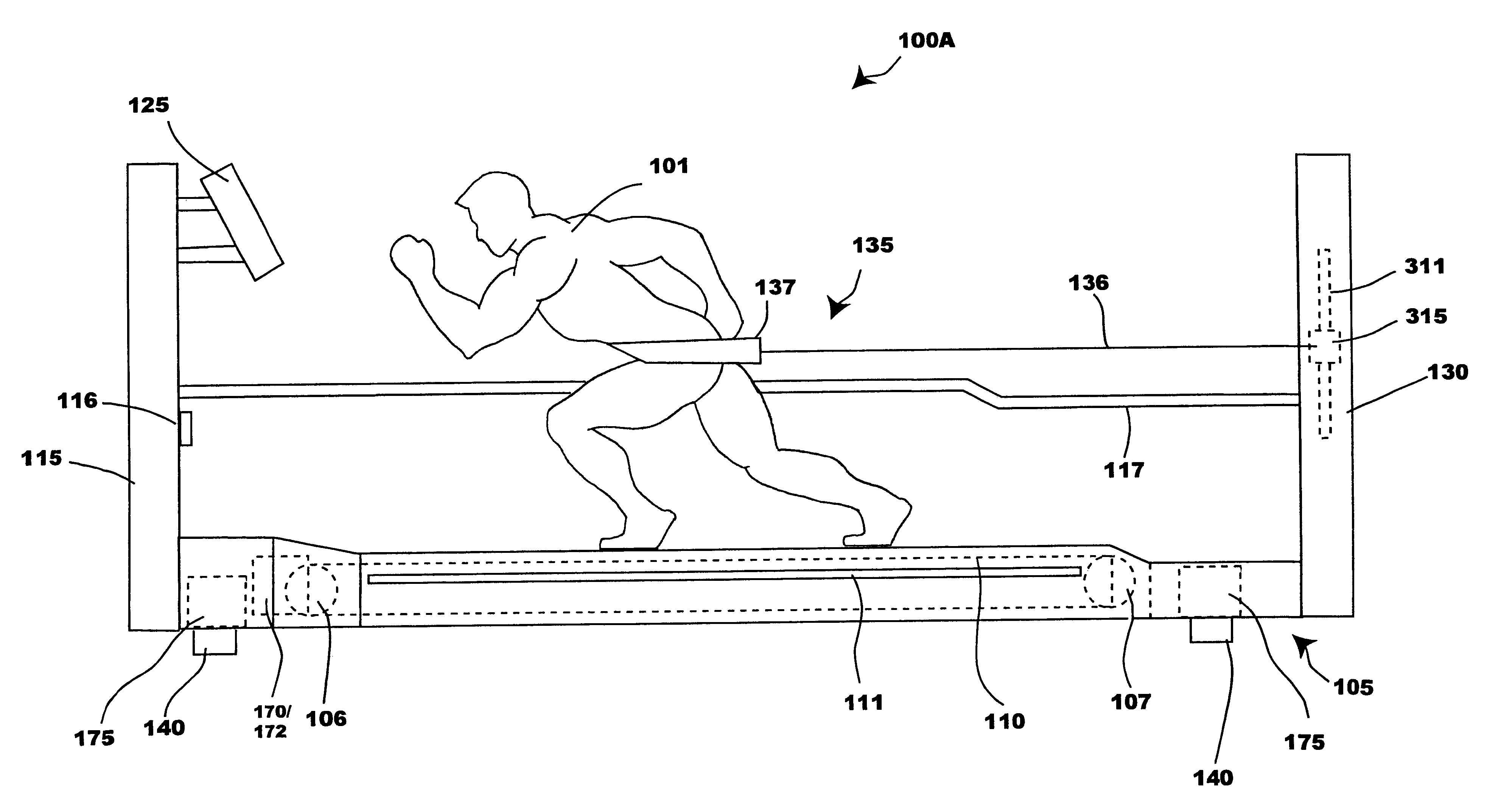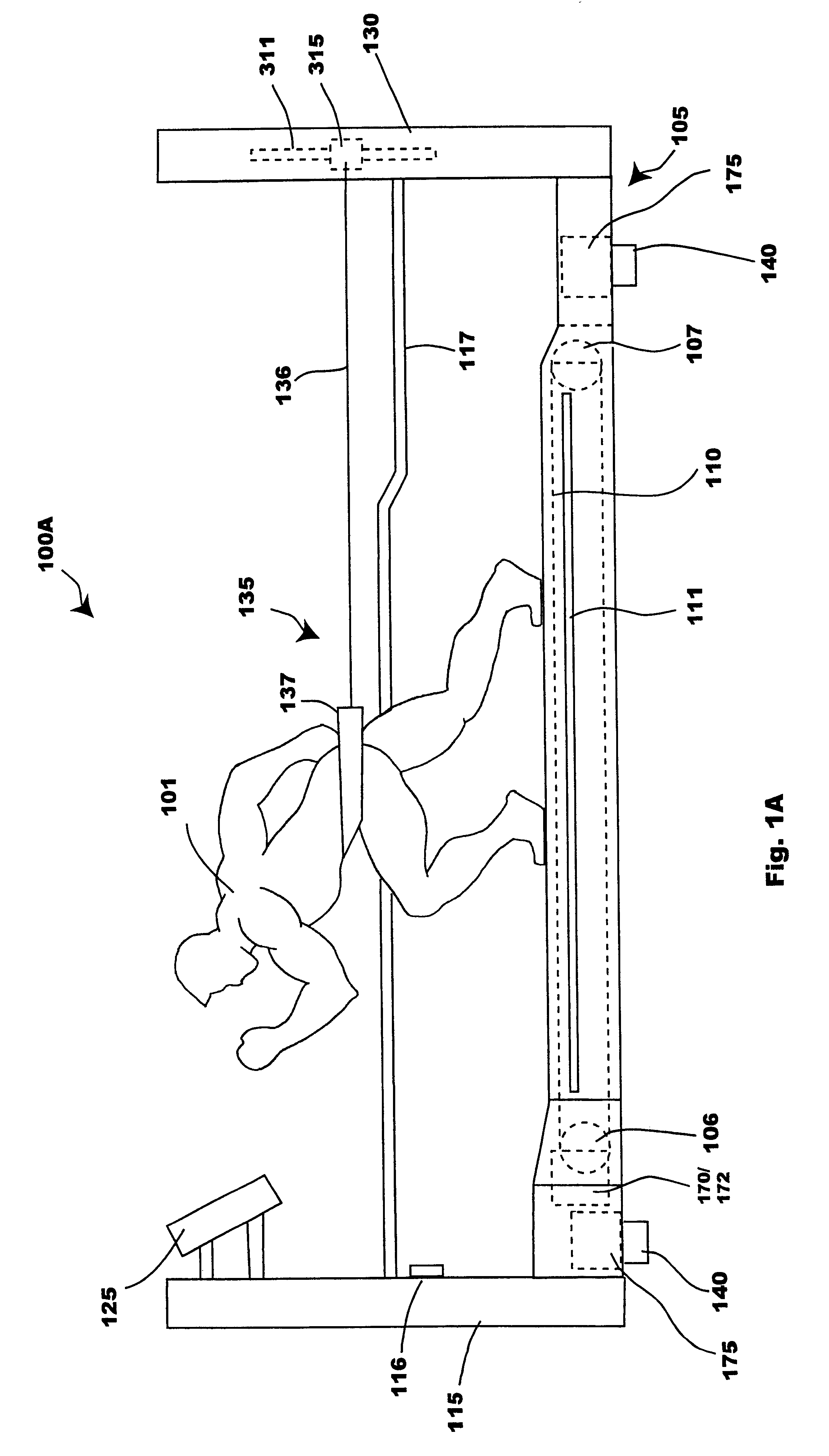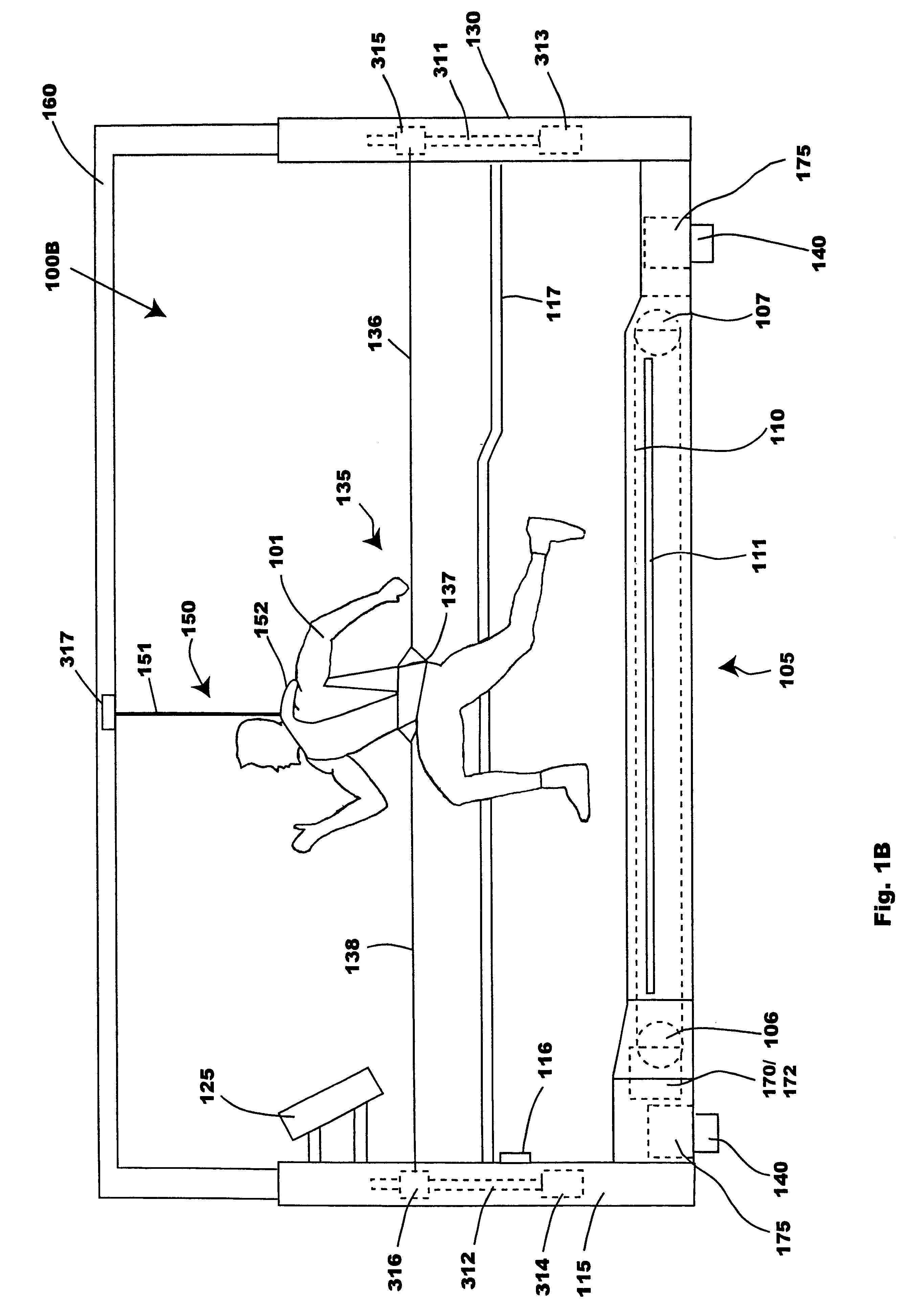Yet, with all the resources applied to the design and development of
exercise equipment, there is a lack of
exercise equipment and
monitoring methods designed specifically to allow one to target specific types of
muscle fiber, and / or operate at multiple extrema of the force-velocity-duration space (particularly in the course of sport-specific motions, especially sport-specific motions requiring bipedal locomotion), and / or accurately measuring "intensity" of exercise.
Although the fitness equipment industry has produced a wide variety of exercise bicycles,
rowing machines, stair simulators, elliptical trainers, etc., in general an athlete cannot perform the
modes of motion associated with most sports, particularly sports involving bipedal locomotion, on such exercise machines.
Therefore, a major obstacle to the practice of sport-specific training is the difficulty of training in a focused manner using the
modes of motion involved in a sport.
Even
treadmill training of athletes whose sports require running has severe limitations, since the majority of athletes do not engage in bipedal locomotion without direction changes at a
constant velocity over long durations (the exception possibly being distance runners).
A particular sprinter might not be able to accelerate well at very low velocities, but may have a high
terminal velocity.
In contrast, another sprinter might have good acceleration capabilities at low velocities, but may not be able to reach a high
terminal velocity.
And even in the acceleration phase, a sprinter may have weaknesses in acceleration ability at one or more ranges of intermediate velocities.
(I) than fast-twitch muscle fibers but, because aerobic processes are renewable due to their re-energization by
oxygen-carrying
blood flow to the fibers, they have a longer useful
exertion period T.sup.
Type IIb fibers are capable of high contractile velocities, but are unable to maintain these contraction rates for more than a few cycles without a re-energization period.
However,
glycolysis cannot be relied upon for endurance events, even for elite athletes, because the
lactic acid will eventually inhibit muscles from contracting.
According to the all-or-nothing theory, an
exercise program targeting only the median range of a subject's force and velocity capabilities may fail to produce contractions of all the muscle fibers, leaving some fast-twitch and slow-twitch fibers unaccessed.
According to the recent studies on
neural control of muscle fiber, an
exercise program targeting only the median range of a subject's force and velocity capabilities may fail to produce changes in the neural
physiology required to increase the firing rate of the fibers, and therefore will be less than optimal in the development of
muscle tissue.
For instance, the arms of a power lifter performing a bench press must generate large forces at small and intermediate velocities for relatively short periods of time.
Furthermore, especially for complex movements such as the bipedal locomotion of a sprint, one of the limiting factors in increasing a subject's
terminal velocity V.sub.max is the subject's coordination.
However, it should be noted that the tow-
rope method is somewhat inconvenient, and both of these scenarios for overspeed training are dangerous since muscle failure or loss of balance is likely to result in injury.
In contrast, overspeed training accomplished by running down an actual incline increases the forces of
impact applied to the leg joints, therefore increasing the risk of injury to the leg joints.
These two overspeed
training methods also force the subject to run at a velocity greater than that which the subject can reach on level ground without assistance.
Although it is commonly assumed that
power output (defined as the vector dot product of the force applied by the subject and the velocity) is a useful variable in measuring performance, the use of this variable is actually problematic.
However, electromyographs are generally considered to provide only rough estimates of
muscle activity due to the unpredictability of the conductance of muscle and
skin tissue.
While existing
exercise equipment may provide crude means for measuring force, speed, duration, and / or power, they do not provide an accurate means for measuring
exercise intensity.
Therefore, the design of appropriate training programs for athletes, the comparison of athletes, and the assignment of optimal roles for athletes from a team's talent
pool are clearly complicated and difficult tasks.
Currently-available exercise bikes have a number of deficiencies with regards to the training of athletes for bipedal locomotion.
(U.S. Pat. No. 5,256,115) allows the pedal resistance to be adjusted, but provides no means of immovably securing the subject while forces are applied to the pedals.
Because the legs are generally much stronger than the arms and hands, the forces which can be exerted by the legs on exercise bikes such as Scholder et al. are limited to some degree by the strength with which the subject can grip the
handle bars.
Additionally, the unmonitored motions of the body of the bicyclist result in an uncertainty in the magnitude of the applied forces by the subject, even if the forces on the pedals were to be precisely monitored.
Furthermore, since exercise bikes require a circular, or in some cases elliptical, motion of the feet, they are an imperfect emulation of the motions associated with normal human bipedal locomotion.
Therefore, according to the movement specificity principle, exercise bikes are not well-suited for the training of athletes requiring a high level of performance of bipedal locomotion.
Another
disadvantage of exercise bikes is that they provide no means of exercising muscles in an eccentric fashion.
It should also be noted that currently-available exercise bikes do not have means for altering the velocity as an arbitrary function of the applied forces, or altering the resistance forces as an arbitrary function of the velocity of the pedals.
Many of the disadvantages of currently-available exercise bikes also apply to currently-available staircase emulators, such as in the one described by Potts in U.S. Pat. No. 4,687,195.
It should be noted that Potts allows for the adjustment of the speed of a revolving inclined staircase but, given that it has no means of immovably securing the subject, it does not allow a subject to exert a force greater than the subject's weight so, generally, the exerted force will be substantially less than the maximum zero-velocity force F.sub.max which a subject is capable of.
Also, because the motions of the body of the subject are unmonitored, the magnitude of the forces exerted by the subject cannot be determined even if the forces on the staircase are precisely monitored.
Furthermore, it should be noted that staircase emulators do not allow any variation in
stride length or in the angle from horizontal in which the bipedal locomotion occurs, so, according to the movement specificity principle, they are of limited value for the training of athletes requiring a high level of bipedal locomotion performance.
Additionally, staircase emulators are not operable in reverse, and so cannot provide means for eccentric exercises where there is the capability of producing forces greater than the maximum zero-velocity force F.sub.max which a subject is capable of, thereby obtaining the valuable training benefits associated therewith.
It should also be noted that currently-available staircase emulators do not have means for altering the velocity as an arbitrary function of the applied forces, or altering the resistance forces as an arbitrary function of the velocity, and the maximal speeds of such devices do not approach the terminal velocity of most athletes.
Many of the disadvantages of currently-available exercise bikes and staircase emulators also apply to
treadmill devices, such as in the motorized
treadmill apparatus described by Skowronski in U.S. Pat. No. 5,382,207.
It should be noted that the treadmill device of Skowronski does not provide means for immovably securing the subject.
Therefore, since the legs are generally much stronger than the arms and hands, the forces which can be exerted by the legs are limited by the strength with which the subject can secure his position on the treadmill by gripping whatever surfaces are provided.
It should be noted that although the plane of the treadmill may be inclined upwards, generally the angle of incline is not sufficient to allow the exerted forces to approach the maximum zero-velocity force F.sub.max.
Additionally, the motions of the body, which are unmonitored, result in an uncertainty in the magnitude of the forces exerted by the subject, even if the forces on the treadmill were to be precisely monitored.
Also, most treadmills have a maximum speed of approximately 10
miles per hour, and are therefore inadequate for the training of sprinters.
While some treadmills also allow the conveyor surface to be given a downhill slant, it should be noted that running downhill may produce dangerous increases in the stresses incurred by the leg joints.
Furthermore, since treadmills generally do not provide means for having the belt move in the reverse direction, they cannot target eccentric exertions of the muscles.
Furthermore,
oxygen consumption is only useful in monitoring steady-state aerobic processes.
Therefore, the apparatus of Lloyd only permits the study of
steady state scenarios.
Transient information cannot be monitored using Lloyd's apparatus since the transient information is lost due to the inherent
time averaging which occurs.
Additionally, if the
mass drops rapidly it may somewhat stretch the tether and bounce back upwards, or the
mass may tend to swing back and forth.
Either of these situations produces an unpredictably varying horizontal impeding forces.
exercises cannot be performed over the full range of intensities.
 Login to View More
Login to View More  Login to View More
Login to View More 


